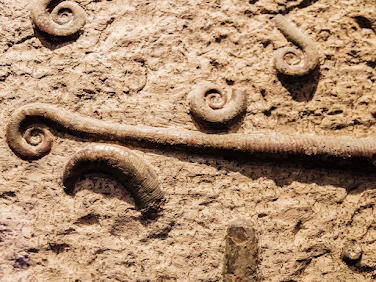 |
| Reindeer, Rangifer tarandus |
This Norwegian archipelago sits between mainland Norway and the North Pole.
One of the world’s northernmost inhabited areas, it is known for its rugged, remote terrain of glaciers and frozen tundra sheltering polar bears, reindeer and Arctic fox.
It is also known for reindeer. The lovelies you see here are all females as the males lose their antlers in the winter. So Rudolf and the rest of Santa's crew who pull his sleigh for him would have all been females as they are pictured with antlers. They are also shown flying across the sky, so the science gets a bit creative.
The Northern Lights or Nordlys are visible during winter, and summer brings the Midnight Sun — sunlight 24 hours a day. Norway or Norge is one of the very few locations where sunset merges into the sunrise, with no darkness in between, creating a soft, captivating twilight in which to view the world.
The Botneheia Formation is made up of dark grey, laminated shales coarsening upwards to laminated siltstones and sandstones. South of the type area, the formation shows four coarsening-upward units.
The formation is named for Botneheia Mountain, a mountain in Nordenskiöld Land at Spitsbergen, Svalbard. It has a height of 522 m.a.s.l., and is located south of Sassenfjorden, east of the valley of De Geerdalen.
 |
| Svalbard, Norway |
You have to remove the snow cover — or ice if you are impatient or unlucky — to get to the outcrops here. It is well worth the effort. Beneath the icy cover, you find lovely ammonoids and bivalves.
Tastier still, ichthyosaur remains are found here. The first Triassic ichthyosaurs from Svalbard were found in the early 20th century. Now there are quite a few Triassic and Jurassic ichthyosaur species from this archipelago.
Two ichthyosaur specimens have been recovered that are of particular interest. They comprise part of the trunk and the caudal vertebral column respectively.
Some features, such as the very high and narrow caudal and posterior thoracic neural spines, the relatively elongate posterior thoracic vertebrae and the long and slender haemapophyses indicate that they probably represent a member of the family Toretocnemidae.
 |
| Ichthyosaur Bones |
There is a resident research group working on the Triassic ichthyosaur fauna, the Spitsbergen Mesozoic Research Group.
Lucky for them, they often find the fossil remains fully articulated — the bones having retained their spatial relationship to one another.
Most of their finds are of the tail sections of primitive Triassic ichthyosaurs. In later ichthyosaurs, the tail vertebrae bend steeply downwards and have more of a fish-like look.
In these primitive ancestors, the tail looks more eel-like — bending slightly so that the spines on the vertebrae form more of the tail.
Maisch, Michael W. and Blomeier, Dierk published on these finds back in 2009: Neues Jahrbuch für Geologie und Paläontologie - Abhandlungen Band 254 Heft 3 (2009), p. 379 - 384. Nov 1, 2009.
 |
| Svalbard, Norway (Norge) |
The first documented travellers to explore Spitsbergen arrived in 1795 as part of a hunting expedition. They included people from the arctic town of Hammerfest in Norway's far north. They were an excellent choice as they were used to barren, inhospitable lands and sailed to discover more.
We know them as the Coast Sámi — a hearty, rugged people probably best known in history for their chieftain, Ottar. He left Hammerfest in the 9th century to visit then join King Alfred the Great's court in a newly forming England.
Expeditions to the remote islands of Svalbard continued into the early 1800s and finally, a settlement was eked out of the cold landscape and slowly expanded to the rest of the islands. While today the islands are called Svalbard, I would have named them for the Norwegian word for remote — fjernkontroll.
 |
| Aristoptychites euglyphus and Daonella sp. |
Daonella and Monotis are important species for our understanding of biostratigraphy in the Triassic and are useful as Index fossils.
Index fossils are fossils used to define and identify geologic periods or faunal stages. To be truly useful, they need to have a short vertical range, wide geographic distribution and rapid evolutionary development.
Daonellids preferred soft, soupy substrates and we tend to find them in massive shell beds. Generally, if you find one, you find a whole bunch cemented together in coquina. The lovely block you see here is in the collections of the deeply awesome John Fam.
Learning Languages
The Sámi languages (/ˈsɑːmi/ SAH-mee), Sami or Saami, are a group of Uralic languages spoken by the Sámi people in Northern Europe in parts of northern Finland, Norway, Sweden, and extreme northwestern Russia. Of the world's languages, I find them the most difficult for my mind and tongue to wrap around. The Uralic languages will be familiar to you as Hungarian (Magyar nyelv), Finnish and Estonian.
Since my Sámi is terrible, I will share a few words of Norwegian that may come in handy if you visit Svalbard and have a hankering for their tasty fossils or fossiler. To say, ice, snow, reindeer and ichthyosaurs in Norwegian, you would say: is, snø, reinsdyr og ikthyosaurer.
To say, "hello, where can I find fossils?" Use, "Hei, hvor kan jeg finne fossiler?" An expression you may not need but circumstances being what they are, "That is a big polar bear," is "Det er en stor isbjørn." A solid follow-up would be, "nice bear, run..." as "Fin bjørn, løp..." Good luck with that.
Wishing you and yours the very best of the holidays however you celebrate.



































